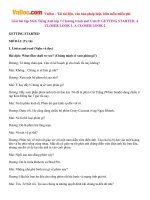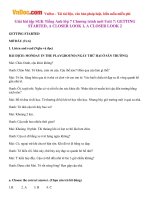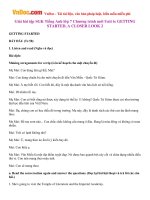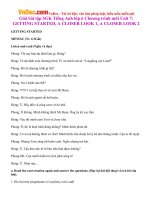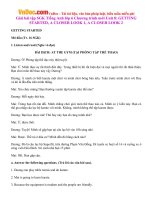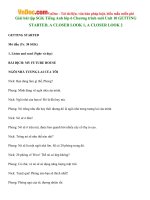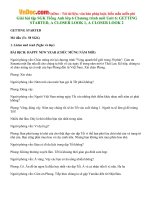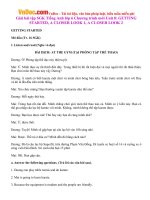Unit 10 E7 Getting started & A closer look 1
Bạn đang xem bản rút gọn của tài liệu. Xem và tải ngay bản đầy đủ của tài liệu tại đây (6.99 MB, 46 trang )
<span class='text_page_counter'>(1)</span><div class='page_container' data-page=1>
<b>REGULATION:</b>
<b> Nội quy lớp </b>
<b>học</b>
<b>1. Vào học đúng giờ (trước 10 phút để giáo viên điểm danh) </b>
<b>2. Có sách giáo khoa tiếng anh tập 2, bút, và vở ghi. </b>
<b>3. Theo dõi giáo viên giảng bài và ghi chép đầy đủ.</b>
<b>4. Chỉ tương tác (chat) với cô giáo khi cô gọi tên. </b>
<b>5. Không tự do nói chuyện với bạn (trên phần chat).</b>
<b>6. Tham gia làm đầy đủ bài kiểm tra cuối buổi học (các cô lấy điểm </b>
<b>vào sổ).</b>
</div>
<span class='text_page_counter'>(2)</span><div class='page_container' data-page=2>
<b>C T R</b>
<b>1</b>
<b>2</b>
<b>3</b>
<b>4</b>
<b>5</b>
<b>6</b>
<b>Column</b>
<b>E</b>
<b>E</b>
<b>Warm up</b>
<b>W I</b>
<b>N</b>
<b>N</b>
<b>D</b>
<b>Y</b>
<b>R</b>
<b>W A</b>
<b>T</b>
<b>E</b>
<b>E</b>
<b>R</b>
<b>R</b>
<b>A S</b>
<b>G</b>
<b>G</b>
<b>R</b>
<b>Y</b>
<b>W</b>
<b>Y</b>
<b>C L E</b>
<b>Do the crossword puzzles</b>
<b>A I</b>
<b>E</b>
<b>E L</b>
<b>I C I T Y</b>
<b>Forward</b>
<b>C</b>
</div>
<span class='text_page_counter'>(3)</span><div class='page_container' data-page=3>
<b>What makes me worried most is </b>
<b>they use </b>
___________
<b>electricity</b>
<b> to catch fish</b>
<b>Back</b>
<b>1</b>
<b>2</b>
<b>3</b>
<b>4</b>
<b>5</b>
<b>6</b>
<b>7</b>
<b>8</b>
<b>9</b>
<b>10</b>
<b>11</b>
<b>12</b>
<b>13</b>
<b>14</b>
<b>15</b>
<b>16</b>
<b>17</b>
<b>18</b>
<b>19</b>
<b>20</b>
</div>
<span class='text_page_counter'>(4)</span><div class='page_container' data-page=4>
<b>It’s </b>
________
<b>windy </b>
<b> today.</b>
<b><sub>Back</sub></b><b>1</b>
<b>2</b>
<b>3</b>
<b>4</b>
<b>5</b>
<b>6</b>
<b>7</b>
<b>8</b>
<b>9</b>
<b>10</b>
<b>11</b>
<b>12</b>
<b>13</b>
<b>14</b>
<b>15</b>
<b>16</b>
<b>17</b>
<b>18</b>
<b>19</b>
<b>20</b>
</div>
<span class='text_page_counter'>(5)</span><div class='page_container' data-page=5>
<b>You shouldn’t throw </b>
<b>trash into the </b>
_______
<b>water</b>
<b>.</b>
<b>Back</b><b>1</b>
<b>2</b>
<b>3</b>
<b>4</b>
<b>5</b>
<b>6</b>
<b>7</b>
<b>8</b>
<b>9</b>
<b>10</b>
<b>11</b>
<b>12</b>
<b>13</b>
<b>14</b>
<b>15</b>
<b>16</b>
<b>17</b>
<b>18</b>
<b>19</b>
<b>20</b>
</div>
<span class='text_page_counter'>(6)</span><div class='page_container' data-page=6>
<b>You should go to school by </b>
<b>bikes instead of motorbikes </b>
<b>to reduce </b>
<b>______ </b>
<b>air</b>
<b>pollution </b>
<b><sub>Back</sub></b><b>1</b>
<b>2</b>
<b>3</b>
<b>4</b>
<b>5</b>
<b>6</b>
<b>7</b>
<b>8</b>
<b>9</b>
<b>10</b>
<b>11</b>
<b>12</b>
<b>13</b>
<b>14</b>
<b>15</b>
<b>16</b>
<b>17</b>
<b>18</b>
<b>19</b>
<b>20</b>
</div>
<span class='text_page_counter'>(7)</span><div class='page_container' data-page=7>
<b>You should save </b>
_______
<b>gas</b>
<b>Back</b>
<b>1</b>
<b>2</b>
<b>3</b>
<b>4</b>
<b>5</b>
<b>6</b>
<b>7</b>
<b>8</b>
<b>9</b>
<b>10</b>
<b>11</b>
<b>12</b>
<b>13</b>
<b>14</b>
<b>15</b>
<b>16</b>
<b>17</b>
<b>18</b>
<b>19</b>
<b>20</b>
</div>
<span class='text_page_counter'>(8)</span><div class='page_container' data-page=8>
<b>We should </b>
_________
<b>waste </b>
<b>paper to save trees.</b>
<b>recycle</b>
<b>Back</b>
<b>1</b>
<b>2</b>
<b>3</b>
<b>4</b>
<b>5</b>
<b>6</b>
<b>7</b>
<b>8</b>
<b>9</b>
<b>10</b>
<b>11</b>
<b>12</b>
<b>13</b>
<b>14</b>
<b>15</b>
<b>16</b>
<b>17</b>
<b>18</b>
<b>19</b>
<b>20</b>
</div>
<span class='text_page_counter'>(9)</span><div class='page_container' data-page=9>
<b>Nick</b>
<b>Mai</b>
<b>Who are they?</b>
<b>What are they talking about?</b>
Unit 10: Sources of energy
Lesson 1:
Getting started
Lesson 1:
</div>
<span class='text_page_counter'>(10)</span><div class='page_container' data-page=10>
<b>- negative effect (n)</b>
<b>- environment (n)</b>
<b>- It’s in the news (exp)</b>
<b>- produce (v)</b>
<b>- (non)-renewable (a)</b>
<b>- run out (n)</b>
<b>- use sth up (v)</b>
<b>- solar panel (n)</b>
<b>: môi trường</b>
<b>: tác động tiêu cực</b>
<b>A. Vocabulary:</b>
<b>: trên bản tin, trên báo chí</b>
<b>: tạo ra</b>
<b>: (không) tái tạo</b>
<b>: cạn kiệt</b>
<b>: sử dụng …. hết</b>
</div>
<span class='text_page_counter'>(11)</span><div class='page_container' data-page=11>
<b>B. LISTEN AND READ</b>
<b>M: Nam, I read yesterday that we all have a</b>
<b>carbon footprint.</b>
<b>N: Well, we all have footprints – we make them with our feet!</b>
<b>M: Ha ha, I know that. But this kind of footprint is about the </b>
<b>negative effect we have on the environment.</b>
<b>N: Right, it’s in the news a lot these days.</b>
</div>
<span class='text_page_counter'>(12)</span><div class='page_container' data-page=12>
<b>M: Right, Nam. Non-renewable energy sources like coal, </b>
<b>natural </b> <b>gas, </b> <b>and </b> <b>oil </b> <b>produce </b> <b>a </b> <b>lot </b> <b>of</b>
<b>carbon dioxide. Those sources are going to run</b>
<b>out soon too.</b>
<b>N: So, they’re different to wind, hydro, and solar?</b>
<b>M: Yes, they’re all sources of energy too, but they’re </b>
<b>renewable. That means we can’t use them all up – they </b>
<b>will last forever.</b>
<b>N: Do you have a big carbon footprint, Mai?</b>
<b>M: Mine’s small. I recycle the products I use and I go </b>
<b>everywhere by bike. We have solar panels on our roof at </b>
<b>home to catch the sun’s energy, too.</b>
</div>
<span class='text_page_counter'>(13)</span><div class='page_container' data-page=13></div>
<span class='text_page_counter'>(14)</span><div class='page_container' data-page=14>
<b>a. </b>
<b>Answer the questions.</b>
<b>1. What is a carbon footprint?</b>
<b>2. What does 'non-renewable energy' mean?</b>
<b>3. Why is sunlight a renewable source?</b>
<b>4. Why does Mai think she has a small carbon </b>
<b>footprint?</b>
</div>
<span class='text_page_counter'>(15)</span><div class='page_container' data-page=15>
<b>1. What is a carbon footprint?</b>
<b>2. What does 'non-renewable energy' mean?</b>
<b>3. Why is sunlight a renewable source?</b>
<b>It’s about the negative effect we have on the </b>
<b>environment.</b>
<b>‘Non-renewable energy’ means that it will </b>
<b>run out if we use it.</b>
</div>
<span class='text_page_counter'>(16)</span><div class='page_container' data-page=16>
<b>4. Why does Mai think she has a small carbon </b>
<b>footprint?</b>
<b>5. What things do you think might create a big </b>
<b>carbon footprint?</b>
<b>The products we use that are bad for the </b>
<b>environment or the energy we use that </b>
<b>produces carbon dioxide might create a </b>
<b>big carbon footprint.</b>
</div>
<span class='text_page_counter'>(17)</span><div class='page_container' data-page=17>
<b>b. Complete the network.</b>
<b>SOURCES </b>
<b>OF </b>
<b>ENERGY</b>
<b>RENEWABL</b>
<b>E SOURCES</b>
<b></b>
<b>NON-RENEWABL</b>
<b>E SOURCES</b>
<b>WIND</b> <b>OIL</b>
<b>HYDRO</b> <b>NATURA<sub>L GAS</sub></b>
</div>
<span class='text_page_counter'>(18)</span><div class='page_container' data-page=18>
<b>I. Listen and repeat the words and phrases.</b>
<b>wind</b>
<b>coal</b>
<b>natural </b>
<b><sub>gas </sub></b>
<b>nuclear</b>
<b>biogas</b>
<b>oil</b>
<b>hydro</b>
<b>solar</b>
</div>
<span class='text_page_counter'>(19)</span><div class='page_container' data-page=19>
<b>II. Put the words into the correct groups below.</b>
<b>wind</b>
<b>coal</b>
<b>natural gas</b>
<b>nuclear</b>
<b>biogas</b>
<b>oil</b>
<b>hydro</b>
<b>solar</b>
<b>Renewable sources</b>
<b>Non-renewable sources</b>
<i><b>Example: </b></i>
<b>wind </b>
<i><b>Example: </b></i>
<b>coal</b>
<b>nuclear</b>
<b>oil</b>
<b>biogas</b>
<b>hydro</b>
<b>solar</b>
</div>
<span class='text_page_counter'>(20)</span><div class='page_container' data-page=20></div>
<span class='text_page_counter'>(21)</span><div class='page_container' data-page=21>
<b>III. Practise asking and answering the questions </b>
<b>about renewable and non renewable sources.</b>
<b>A: </b>
<b>What type of energy source is wind?</b>
<b>B: </b>
<b>It’s a renewable source of energy.</b>
<b>A: </b>
<b>What type of energy source is coal?</b>
</div>
<span class='text_page_counter'>(22)</span><div class='page_container' data-page=22></div>
<span class='text_page_counter'>(23)</span><div class='page_container' data-page=23>
<b>Sources </b>
<b>of energy</b>
</div>
<span class='text_page_counter'>(24)</span><div class='page_container' data-page=24>
<b>Sources </b>
<b>of energy</b>
<b>natural gas</b>
<b>oil</b>
<b>wind</b>
<b>coal</b>
<b>I.Warm up</b> <b><sub>KIM’ S GAME</sub></b>
<b>solar</b>
<b>biogas</b>
<b>nuclear</b>
<b>water</b>
<b>1</b>
<b>2</b>
<b>3</b>
<b>4</b>
<b>5</b>
</div>
<span class='text_page_counter'>(25)</span><div class='page_container' data-page=25>
<b>Lesson 2:</b>
<b>A CLOSER LOOK 1 </b>
<b>Lesson 2:</b>
</div>
<span class='text_page_counter'>(26)</span><div class='page_container' data-page=26>
<b>I. New words.</b>
<b>- limited >< unlimited (adj) :</b>
<b>- abundant = plentiful (adj) :</b>
<b>- available (adj)</b> <b>:</b>
<b>- convenient (adj)</b> <b>:</b>
<b>- harmful (adj)</b> <b>:</b>
<b>- polluting </b> <b>:</b>
<b>- exhausted (adj)</b> <b>:</b>
<b>II. Vocabulary.</b>
<b>Hạn chế >< không hạn chế</b>
<b>Nhiều, dồi dào</b>
<b>Có sẵn</b>
<b>Thuận lợi, thuận tiện</b>
<b>Có hại</b>
<b>Ơ nhiễm</b>
</div>
<span class='text_page_counter'>(27)</span><div class='page_container' data-page=27>
<b>1. Put the words below into the table to describe the types of energy</b>
<b>Source of energy</b> <b>Advantage(s)</b> <b>Disadvantage(s)</b>
<b>wind</b> <b>Example:</b>
<b>abundant</b>
<b>safe</b>
<b>Example:</b>
<b>not always </b>
<b>available</b>
<b>Water/ hydro</b>
<b>solar</b>
<b>biogas</b>
<b>nuclear</b>
<b>Coal/oil/ natural </b>
<b>gas</b>
<b>limited unlimited harmful renewable non-renewable </b>
<b>exhaustible safe dangerous convenient clean </b>
</div>
<span class='text_page_counter'>(28)</span><div class='page_container' data-page=28>
<b>1. Put the words below into the table to describe the types of energy</b>
<b>Source of energy</b> <b>Advantage(s)</b> <b>Disadvantage(s)</b>
<b>wind power</b> <b>abundant, unlimited not available</b>
<b>water power</b> <b>clean and safe</b> <b>expensive, not </b>
<b>available</b>
<b>solar energy</b> <b>renewable, plentiful, </b>
<b>clean and safe</b> <b>expensive</b>
<b>biogas</b> <b>renewable, plentiful </b>
<b>available, clean and </b>
<b>safe</b>
<b>abundant, cheap </b>
<b>nuclear energy</b> <b>renewable, clean and </b>
<b>safe</b> <b>expensive, dangerous </b>
<b>coal/oil/natural </b>
</div>
<span class='text_page_counter'>(29)</span><div class='page_container' data-page=29>
2. Compare your answers with a partner.
<b>Example: </b>
<b>+ A: I think biogas is renewable</b>
<b> B: Me too. I also think it is abundant </b>
<b>and cheap</b>
</div>
<span class='text_page_counter'>(30)</span><div class='page_container' data-page=30>
<b>3. Look at the pictures and complete these sentences, using </b>
<b>the words in 1.</b>
</div>
<span class='text_page_counter'>(31)</span><div class='page_container' data-page=31></div>
<span class='text_page_counter'>(32)</span><div class='page_container' data-page=32></div>
<span class='text_page_counter'>(33)</span><div class='page_container' data-page=33>
<b>4. Nuclear energy is renewable and clean. But it is ………. </b>
<b>and……….</b>
</div>
<span class='text_page_counter'>(34)</span><div class='page_container' data-page=34>
<b>III. Pronunciation </b>
<b>1. Two syllables:</b>
<b>+) Most nouns and adjectives, stress on the first </b>
<b>syllable.</b>
<b>E.g: </b>
<b>’mountain ’evening ’butcher </b>
<b>’carpet ’busy ’village </b>
<b>+) Most verbs , stress on the second syllable.</b>
<b>E.g: </b>
<b>Ex’plain de’scend for’get </b>
</div>
<span class='text_page_counter'>(35)</span><div class='page_container' data-page=35>
<b>2. Three syllables. (Trọng âm trong từ có "3 ÂM TIẾT“)</b>
<b>a. Động từ.</b>
- Trọng âm rơi vào âm tiết thứ 2 nếu âm tiết thứ 3 có
nguyên âm ngắn và kết thúc bằng 1 phụ âm:
<b>Ex: </b> <b>encounter /iŋ’kauntə/, determine /di’tɜ:min/</b>
- Trọng âm sẽ rơi vào âm tiết thứ nhất nếu âm tiết thứ 3 là
nguyên âm dài hay nguyên âm đôi hay kết thúc bằng 2 phụ
âm trở lên.
<b>Ex: </b> <b>exercise /’eksəsaiz/, </b> <b>compromise/’kɒmprǝmaiz/</b>
<b>* Một số trường hợp ngoại lệ: </b>
</div>
<span class='text_page_counter'>(36)</span><div class='page_container' data-page=36>
<b>b. Danh từ, tính từ.</b>
- Đối với danh từ có ba âm tiết: nếu âm tiết thứ hai có chứa âm /ə/
hoặc /i/ thì trọng âm sẽ rơi vào âm tiết thứ nhất.
<b>Ex: </b> <b>paradise /ˈpærədaɪs /, pharmacy /ˈfɑːrməsi/, </b>
<b>holiday /ˈhɑːlədeɪ /, </b> <b>resident /ˈrezɪdənt/…</b>
<b>happiness /’hæpinis/, </b> <b>impossible /im’pɔsəbl/…</b>
- Nếu các danh từ có âm tiết thứ nhất chứa âm ngắn (/ə/ hay/i/)
hoặc có âm tiết thứ hai chứa ngun âm dài/ ngun âm đơi thì
trọng âm rơi vào âm tiết thứ hai.
</div>
<span class='text_page_counter'>(37)</span><div class='page_container' data-page=37>
<b>4. Listen and repeat. Which words are stressed on the first </b>
<b>syllable and which ones are stressed on the second syllable? </b>
<b>Put them in the appropriate columns.</b>
<b>Dangerous enormous limited</b>
<b>Easily expensive plentiful</b>
<b>Abundant energy convenient</b>
<b>Ooo</b>
<b>oOo</b>
</div>
<span class='text_page_counter'>(38)</span><div class='page_container' data-page=38>
<b>4.</b> <b>Listen and repeat. Which words are stressed on the first syllable and </b>
<b>which ones are stressed on the second syllable? Put them in the </b>
<b>appropriate columns.</b>
<b>Dangerous enormous limited</b>
<b>Easily expensive plentiful</b>
<b>Abundant energy convenient</b>
<b>Ooo</b>
<b>oOo</b>
- <b>Dangerous</b>
- <b>Plentiful </b>
- <b>Limited </b>
- <b>Easily </b>
- <b>Energy </b>
</div>
<span class='text_page_counter'>(39)</span><div class='page_container' data-page=39>
<b>5. Read the following sentences and mark (’) the </b>
<b>stressed syllable in the underlined words. Then </b>
<b>listen, check and repeat.</b>
<b>1. Coal will be replaced by another renewable source.</b>
<b>2. Wind power is convenient and abundant.</b>
<b>3. Natural gas is limited and it is harmful to the </b>
<b>environment.</b>
</div>
<span class='text_page_counter'>(40)</span><div class='page_container' data-page=40>
<b>5. Read the following sentences and mark (‘) the stressed </b>
<b>syllable in the underlined words. Then listen, check and </b>
<b>repeat.</b>
<b>1. Coal will be replaced by a’nother re’newable source.</b>
<b>2. Wind power is con’venient and a’bundant.</b>
<b>3. Natural gas is ’limited and it is harmful to the </b>
<b>en’vironment.</b>
<b>4. Solar energy is ’plentiful and it can be replaced ’easily.</b>
<b>5. Nuclear power is ex’pensive and ’dangerous.</b>
</div>
<span class='text_page_counter'>(41)</span><div class='page_container' data-page=41>
<b>Exercise 1: Put the words in the table in the correct column </b>
<b>according to their stress pattern.</b>
<b>Stress on 1st syllable</b> <b>Stress on 2nd syllable</b>
<b>’calendar ’exercise</b>
<b>’travelling </b> <b>’similar </b>
<b>’marvelous</b> <b>excellent </b>
<b>’wonderful ’biogas</b>
<b>’scientist ’energy</b>
<b>’dangerous</b> <b>’excellent</b>
<b>’plentiful</b>
<b>Con’venience fa’miliar</b>
<b>Im’portant</b> <b> a’bundant</b>
<b>Con’venient mu’sician</b>
<b>Po’lluting</b>
<b>convenience</b> <b>calendar</b> <b>exercise</b> <b>travelling</b>
<b>similar</b> <b>marvelous</b> <b>excellent familiar</b>
<b>important</b> <b>wonderful</b> <b>abundant convenient</b>
<b>biogas</b> <b>scientist</b> <b>musician energy</b>
</div>
<span class='text_page_counter'>(42)</span><div class='page_container' data-page=42>
<b>Exercise 2: Choose the word that has different syllable stress </b>
<b>position.</b>
<b>1. A. domestic</b> <b>B. investment</b>
<b>C. substantial</b> <b>D. fascinate</b>
<b>2. A. confident</b> <b>B. influence</b>
<b>C. management</b> <b>D. remember</b>
<b>3. A. optimist</b> <b>B. distribute</b>
<b>C. terrorist</b> <b>D. contrary</b>
<b>4. A. government</b> <b>B. destruction</b>
<b>C. contribute</b> <b>D. depression</b>
<b>5. A. institute</b> <b>B. consumption</b>
</div>
<span class='text_page_counter'>(43)</span><div class='page_container' data-page=43>
<b>Exercise 3: Choose the best option to fill in the blank.</b>
<b>1. When you save energy, you not only save money, you also</b>
<b>reduce the demand for ... such as coal, oil, and natural</b>
<b>Gas and that is a great way to play a part in saving the planet.</b>
<b>A. carbon footprint</b> <b>B. electricity</b>
<b>C. fossil fuels</b> <b>D. biogas</b>
<b>2. In India, the demand for ... has always been more </b>
<b>than the supply.</b>
<b>A. shortage</b> <b>B. sources</b> <b>C. slogan D. electricity</b>
<b>3. ... energy is produced by collecting sunlight and </b>
<b>converting it into electricity.</b>
</div>
<span class='text_page_counter'>(44)</span><div class='page_container' data-page=44>
<b>4. There are many available ... power sources in</b>
<b>Vietnam including sun, wind, water, etc.</b>
<b>A. nuclear</b> <b>B. hydro</b>
<b>C. renewable</b> <b>D. solar</b>
<b>5. Laos and Cambodia have big plans for building up to 11</b>
<b>... on the lower Mekong.</b>
</div>
<span class='text_page_counter'>(45)</span><div class='page_container' data-page=45>
<b>Homework</b>
<b>• Learn by heart all the new </b>
<b>words.</b>
</div>
<span class='text_page_counter'>(46)</span><div class='page_container' data-page=46></div>
<!--links-->
